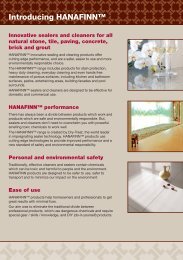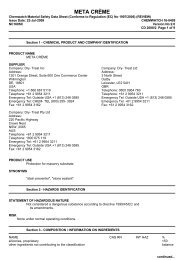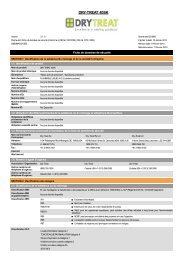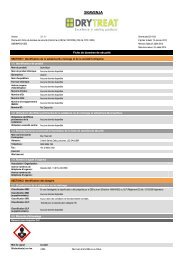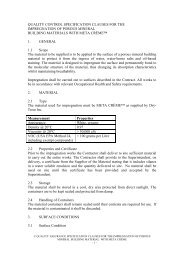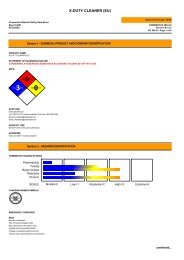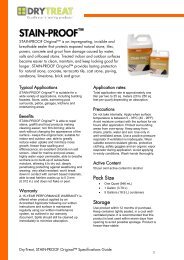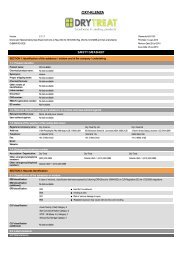ole-repella™ msds aus - Dry Treat
ole-repella™ msds aus - Dry Treat
ole-repella™ msds aus - Dry Treat
Create successful ePaper yourself
Turn your PDF publications into a flip-book with our unique Google optimized e-Paper software.
HANAFINN OLÉ-REPELLA<br />
Hazard Alert Code: NIL<br />
Chemwatch GHS Safety Data Sheet<br />
Issue Date: 21-Sep-2010 CHEMWATCH 18-1135<br />
XC554SP Version No:2.1.1.1<br />
Page 1 of 7<br />
PRODUCT NAME<br />
HANAFINN OLÉ-REPELLA<br />
OTHER NAMES<br />
"stain preventer", "stone sealant"<br />
PRODUCT USE<br />
Protection for masonry substrate.<br />
Section 1 - CHEMICAL PRODUCT AND COMPANY IDENTIFICATION<br />
SUPPLIER<br />
Company: <strong>Dry</strong>- <strong>Treat</strong> Pty Ltd Company: <strong>Dry</strong>- <strong>Treat</strong> Ltd<br />
Address: Address:<br />
65 Nicholson Street 3 North Street<br />
St. Leonards Oatby<br />
NSW, 2065 Leicester, LE2 5AH<br />
Australia United Kingdom of Great Britain and Northern<br />
Telephone: 1800 675 119 Ireland<br />
Emergency Tel:Outside USA +1 (813) 248 0585 Telephone: 0800 0964 760<br />
Fax: +61 2 9954 3162 Emergency Tel:Outside USA +1 (813) 248 0585<br />
Fax: +61 2 9954 3162<br />
Company: <strong>Dry</strong>- <strong>Treat</strong> Inc.<br />
Address:<br />
1104 Philadelphia Pike<br />
Willmington<br />
DE, 19809<br />
United States of America<br />
Telephone: +1 866 667 5119<br />
Emergency Tel:(800) 255 3924<br />
Emergency Tel:Outside USA +1 (813) 248 0585<br />
Fax: +61 2 9954 3162<br />
CHEMWATCH HAZARD RATINGS<br />
Flammability<br />
Toxicity<br />
Body Contact<br />
Reactivity<br />
Chronic<br />
GHS Classification<br />
Acute Aquatic Hazard Category 3<br />
EMERGENCY OVERVIEW<br />
HAZARD<br />
Section 2 - HAZARDS IDENTIFICATION<br />
SCALE: Min/Nil=0 Low=1 Moderate=2 High=3 Extreme=4<br />
continued...
HANAFINN OLÉ-REPELLA<br />
Hazard Alert Code: NIL<br />
Chemwatch GHS Safety Data Sheet<br />
Issue Date: 21-Sep-2010 CHEMWATCH 18-1135<br />
XC554SP Version No:2.1.1.1<br />
Page 2 of 7<br />
Section 2 - HAZARDS IDENTIFICATION<br />
Determined by Chemwatch using GHS criteria<br />
H402 Harmful to aquatic life<br />
PRECAUTIONARY STATEMENTS<br />
Prevention<br />
Code Phrase<br />
P273 Avoid release to the environment.<br />
Disposal<br />
Code Phrase<br />
P501 Dispose of contents/container to ...<br />
Section 3 - COMPOSITION / INFORMATION ON INGREDIENTS<br />
NAME CAS RN %<br />
No hazardous ingredients present [Manufacturer]<br />
Section 4 - FIRST AID MEASURES<br />
SWALLOWED<br />
• Immediately give a glass of water.<br />
• First aid is not generally required. If in doubt, contact a Poisons Information Centre or a doctor.<br />
EYE<br />
■ If this product comes in contact with eyes:<br />
• Wash out immediately with water.<br />
• If irritation continues, seek medical attention.<br />
• Removal of contact lenses after an eye injury should only be undertaken by skilled personnel.<br />
SKIN<br />
■ If skin or hair contact occurs:<br />
• Flush skin and hair with running water (and soap if available).<br />
• Seek medical attention in event of irritation.<br />
INHALED<br />
• If fumes, aerosols or combustion products are inhaled remove from contaminated area.<br />
• Other measures are usually unnecessary.<br />
NOTES TO PHYSICIAN<br />
<strong>Treat</strong> symptomatically.<br />
Section 5 - FIRE FIGHTING MEASURES<br />
EXTINGUISHING MEDIA<br />
■ The product contains a substantial proportion of water, therefore there are no restrictions on the type of extinguishing media<br />
which may be used. Choice of extinguishing media should take into account surrounding areas.<br />
Though the material is non-combustible, evaporation of water from the mixture, c<strong>aus</strong>ed by the heat of nearby fire, may produce<br />
floating layers of combustible substances.<br />
In such an event consider:<br />
• foam.<br />
FIRE FIGHTING<br />
• Alert Fire Brigade and tell them location and nature of hazard.<br />
• Wear breathing apparatus plus protective gloves in the event of a fire.<br />
• Prevent, by any means available, spillage from entering drains or water courses.<br />
• Use fire fighting procedures suitable for surrounding area.<br />
FIRE/EXPLOSION HAZARD<br />
• The material is not readily combustible under normal conditions.<br />
• However, it will break down under fire conditions and the organic component may burn.<br />
continued...
HANAFINN OLÉ-REPELLA<br />
Hazard Alert Code: NIL<br />
Chemwatch GHS Safety Data Sheet<br />
Issue Date: 21-Sep-2010 CHEMWATCH 18-1135<br />
XC554SP Version No:2.1.1.1<br />
Page 3 of 7<br />
Section 5 - FIRE FIGHTING MEASURES<br />
• Not considered to be a significant fire risk.<br />
• Heat may c<strong>aus</strong>e expansion or decomposition with vi<strong>ole</strong>nt rupture of containers.<br />
Decomposes on heating and produces toxic fumes of: carbon dioxide (CO2), phosphorus oxides (POx), hydrogen fluoride, other<br />
pyrolysis products typical of burning organic material.<br />
May emit poisonous fumes.<br />
FIRE INCOMPATIBILITY<br />
■ None known.<br />
Section 6 - ACCIDENTAL RELEASE MEASURES<br />
MINOR SPILLS<br />
• Clean up all spills immediately.<br />
• Avoid breathing vapours and contact with skin and eyes.<br />
• Control personal contact with the substance, by using protective equipment.<br />
• Contain and absorb spill with sand, earth, inert material or vermiculite.<br />
MAJOR SPILLS<br />
Moderate hazard.<br />
• Clear area of personnel and move upwind.<br />
• Alert Fire Brigade and tell them location and nature of hazard.<br />
• Wear breathing apparatus plus protective gloves.<br />
• Prevent, by any means available, spillage from entering drains or water course.<br />
Personal Protective Equipment advice is contained in Section 8 of the MSDS.<br />
PROCEDURE FOR HANDLING<br />
• Avoid all personal contact, including inhalation.<br />
• Wear protective clothing when risk of exposure occurs.<br />
• Use in a well-ventilated area.<br />
• Prevent concentration in hollows and sumps.<br />
SUITABLE CONTAINER<br />
• Polyethylene or polypropylene container.<br />
• Packing as recommended by manufacturer.<br />
• Check all containers are clearly labelled and free from leaks.<br />
STORAGE INCOMPATIBILITY<br />
None known.<br />
STORAGE REQUIREMENTS<br />
• Store in original containers.<br />
• Keep containers securely sealed.<br />
• Store in a cool, dry, well-ventilated area.<br />
• Store away from incompatible materials and foodstuff containers.<br />
EXPOSURE CONTROLS<br />
MATERIAL DATA<br />
HANAFINN OLÉ-REPELLA:<br />
Not available<br />
Section 7 - HANDLING AND STORAGE<br />
Section 8 - EXPOSURE CONTROLS / PERSONAL PROTECTION<br />
continued...
HANAFINN OLÉ-REPELLA<br />
Hazard Alert Code: NIL<br />
Chemwatch GHS Safety Data Sheet<br />
Issue Date: 21-Sep-2010 CHEMWATCH 18-1135<br />
XC554SP Version No:2.1.1.1<br />
Page 4 of 7<br />
Section 8 - EXPOSURE CONTROLS / PERSONAL PROTECTION<br />
PERSONAL PROTECTION<br />
RESPIRATOR<br />
•Type A Filter of sufficient capacity. (AS/NZS 1716 & 1715, EN 143:2000 & 149:2001, ANSI Z88 or national equivalent)<br />
EYE<br />
• Safety glasses with side shields<br />
• Chemical goggles.<br />
• Contact lenses may pose a special hazard; soft contact lenses may absorb and concentrate irritants. A written policy document,<br />
describing the wearing of lens or restrictions on use, should be created for each workplace or task. This should include a<br />
review of lens absorption and adsorption for the class of chemicals in use and an account of injury experience. Medical and<br />
first-aid personnel should be trained in their removal and suitable equipment should be readily available. In the event of<br />
chemical exposure, begin eye irrigation immediately and remove contact lens as soon as practicable. Lens should be removed at<br />
the first signs of eye redness or irritation - lens should be removed in a clean environment only after workers have washed<br />
hands thoroughly. [CDC NIOSH Current Intelligence Bulletin 59], [AS/NZS 1336 or national equivalent].<br />
HANDS/FEET<br />
■ The selection of the suitable gloves does not only depend on the material, but also on further marks of quality which vary from<br />
manufacturer to manufacturer. Where the chemical is a preparation of several substances, the resistance of the glove material can<br />
not be calculated in advance and has therefore to be checked prior to the application.<br />
The exact break through time for substances has to be obtained from the manufacturer of the protective gloves and<br />
has to be observed when making a final choice.<br />
Suitability and durability of glove type is dependent on usage. Important factors in the selection of gloves include:.<br />
• Wear chemical protective gloves, e.g. PVC.<br />
• Wear safety footwear or safety gumboots, e.g. Rubber.<br />
OTHER<br />
• Overalls.<br />
• P.V.C. apron.<br />
• Barrier cream.<br />
• Skin cleansing cream.<br />
ENGINEERING CONTROLS<br />
■ Engineering controls are used to remove a hazard or place a barrier between the worker and the hazard. Well-designed<br />
engineering controls can be highly effective in protecting workers and will typically be independent of worker interactions to<br />
provide this high level of protection.<br />
The basic types of engineering controls are:<br />
Process controls which involve changing the way a job activity or process is done to reduce the risk.<br />
Enclosure and/or isolation of emission source which keeps a selected hazard "physically" away from the worker and ventilation<br />
that strategically "adds" and "removes" air in the work environment.<br />
APPEARANCE<br />
Liquid; partially miscible with water.<br />
PHYSICAL PROPERTIES<br />
Liquid.<br />
Section 9 - PHYSICAL AND CHEMICAL PROPERTIES<br />
State Liquid M<strong>ole</strong>cular Weight Not Applicable<br />
Melting Range (°C) Not Available Viscosity Not Available<br />
Boiling Range (°C) Not Available Solubility in water (g/L) Partly Miscible<br />
Flash Point (°C) Not Applicable pH (1% solution) Not Available<br />
Decomposition Temp (°C) Not Available pH (as supplied) Not Applicable<br />
Autoignition Temp (°C) Not Applicable Vapour Pressure (kPa) Not Available<br />
Upper Explosive Limit (%) Not Applicable Specific Gravity (water=1) 1.01<br />
Lower Explosive Limit (%) Not Applicable Relative Vapour Density Not Available<br />
(air=1)<br />
Volatile Component (%vol) Not Available Evaporation Rate Not Available<br />
continued...
HANAFINN OLÉ-REPELLA<br />
Hazard Alert Code: NIL<br />
Chemwatch GHS Safety Data Sheet<br />
Issue Date: 21-Sep-2010 CHEMWATCH 18-1135<br />
XC554SP Version No:2.1.1.1<br />
Page 5 of 7<br />
CONDITIONS CONTRIBUTING TO INSTABILITY<br />
• Presence of incompatible materials.<br />
• Product is considered stable.<br />
• Hazardous polymerisation will not occur.<br />
For incompatible materials - refer to Section 7 - Handling and Storage.<br />
Section 10 - CHEMICAL STABILITY<br />
Section 11 - TOXICOLOGICAL INFORMATION<br />
Health hazard summary table:<br />
Acute toxicity Not applicable<br />
Skin corrosion/irritation Not applicable<br />
Serious eye damage/irritation Not applicable<br />
Respiratory or skin sensitization Not applicable<br />
Germ cell mutagenicity Not applicable<br />
Carcinogenicity Not applicable<br />
Reproductive toxicity Not applicable<br />
STOT- single exposure Not applicable<br />
STOT- repeated exposure Not applicable<br />
Aspiration hazard Not applicable<br />
POTENTIAL HEALTH EFFECTS<br />
ACUTE HEALTH EFFECTS<br />
SWALLOWED<br />
■ Considered an unlikely route of entry in commercial/industrial environments.<br />
■ The material has NOT been classified by EC Directives or other classification systems as "harmful by ingestion".<br />
This is bec<strong>aus</strong>e of the lack of corroborating animal or human evidence.<br />
EYE<br />
■ Although the liquid is not thought to be an irritant (as classified by EC Directives), direct contact with the eye may produce<br />
transient discomfort characterised by tearing or conjunctival redness (as with windburn).<br />
SKIN<br />
■ The liquid may be miscible with fats or oils and may degrease the skin, producing a skin reaction described as non-allergic<br />
contact dermatitis.<br />
The material is unlikely to produce an irritant dermatitis as described in EC Directives .<br />
■ Open cuts, abraded or irritated skin should not be exposed to this material.<br />
■ Entry into the blood-stream, through, for example, cuts, abrasions or lesions, may produce systemic injury with harmful effects.<br />
Examine the skin prior to the use of the material and ensure that any external damage is suitably protected.<br />
INHALED<br />
■ The material is not thought to produce adverse health effects or irritation of the respiratory tract (as classified by EC<br />
Directives using animal models).<br />
Nevertheless, good hygiene practice requires that exposure be kept to a minimum and that suitable control measures be used in an<br />
occupational setting.<br />
■ Not normally a hazard due to non-volatile nature of product.<br />
CHRONIC HEALTH EFFECTS<br />
Principal routes of exposure are by accidental skin and eye contact and by inhalation of vapours especially at higher<br />
temperatures.<br />
As with any chemical product, contact with unprotected bare skin; inhalation of vapour, mist or dust in work place atmosphere; or<br />
ingestion in any form, should be avoided by observing good occupational work practice.<br />
TOXICITY AND IRRITATION<br />
■ Not available. Refer to individual constituents.<br />
continued...
HANAFINN OLÉ-REPELLA<br />
Hazard Alert Code: NIL<br />
Chemwatch GHS Safety Data Sheet<br />
Issue Date: 21-Sep-2010 CHEMWATCH 18-1135<br />
XC554SP Version No:2.1.1.1<br />
Page 6 of 7<br />
Harmful to aquatic organisms.<br />
Section 12 - ECOLOGICAL INFORMATION<br />
Ecotoxicity<br />
Ingredient Persistence: Persistence: Air Bioaccumulation Mobility<br />
Water/Soil<br />
HANAFINN OLÉ- REPELLA No Data No Data No Data No Data<br />
Available Available Available Available<br />
Section 13 - DISPOSAL CONSIDERATIONS<br />
■ Legislation addressing waste disposal requirements may differ by country, state and/ or territory. Each user must refer to<br />
laws operating in their area.<br />
A Hierarchy of Controls seems to be common - the user should investigate:<br />
• Reduction.<br />
• DO NOT allow wash water from cleaning or process equipment to enter drains.<br />
• It may be necessary to collect all wash water for treatment before disposal.<br />
• In all cases disposal to sewer may be subject to local laws and regulations and these should be considered first.<br />
• Where in doubt contact the responsible authority.<br />
• Recycle wherever possible.<br />
• Consult manufacturer for recycling options or consult local or regional waste management authority for disposal if no suitable<br />
treatment or disposal facility can be identified.<br />
• Dispose of by: burial in a land-fill specifically licenced to accept chemical and / or pharmaceutical wastes or incineration in<br />
a licenced apparatus (after admixture with suitable combustible material).<br />
• Decontaminate empty containers. Observe all label safeguards until containers are cleaned and destroyed.<br />
HAZCHEM:<br />
None (ADG7)<br />
Section 14 - TRANSPORTATION INFORMATION<br />
NOT REGULATED FOR TRANSPORT OF DANGEROUS GOODS: UN, IATA, IMDG<br />
POISONS SCHEDULE None<br />
REGULATIONS<br />
No data for HANAFINN OLÉ-REPELLA (CW: 18-1135)<br />
Section 15 - REGULATORY INFORMATION<br />
Section 16 - OTHER INFORMATION<br />
■ Classification of the preparation and its individual components has drawn on official and authoritative sources as well as<br />
independent review by the Chemwatch Classification committee using available literature references.<br />
A list of reference resources used to assist the committee may be found at:<br />
www.chemwatch.net/references.<br />
■ The (M)SDS is a Hazard Communication tool and should be used to assist in the Risk Assessment. Many factors determine whether<br />
the reported Hazards are Risks in the workplace or other settings.<br />
continued...
HANAFINN OLÉ-REPELLA<br />
Hazard Alert Code: NIL<br />
Chemwatch GHS Safety Data Sheet<br />
Issue Date: 21-Sep-2010 CHEMWATCH 18-1135<br />
XC554SP Version No:2.1.1.1<br />
Page 7 of 7<br />
Section 16 - OTHER INFORMATION<br />
This document is copyright. Apart from any fair dealing for the purposes of private study, research, review or<br />
criticism, as permitted under the Copyright Act, no part may be reproduced by any process without written<br />
permission from CHEMWATCH. TEL (+61 3) 9572 4700.<br />
Issue Date: 21-Sep-2010<br />
Print Date: 11-Feb-2013



